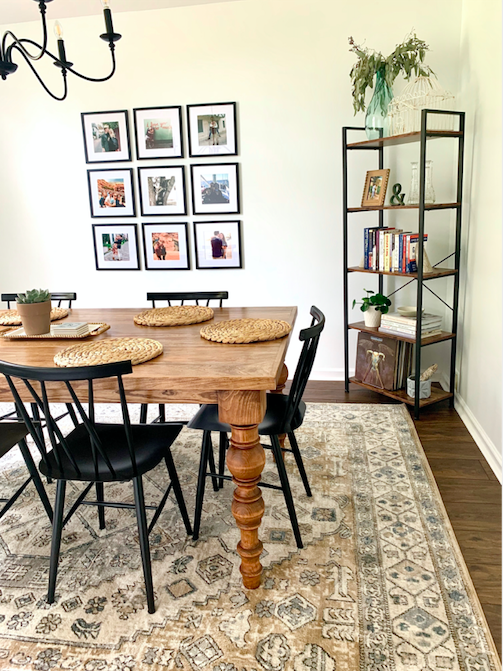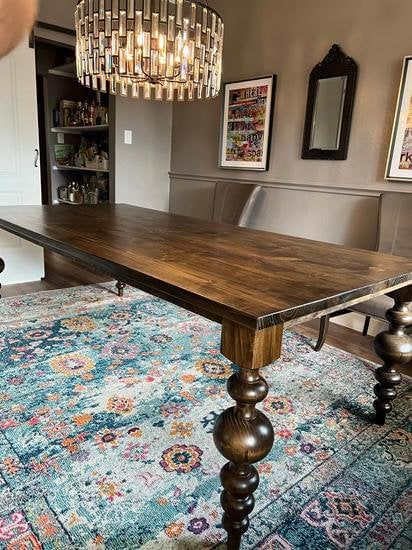How Dining Room Table Legs Can Change the Entire Aesthetic of Your Room
How Dining Room Table Legs Can Change the Entire Aesthetic of Your Room
Blog Article
Just How to Pick the Perfect Dining-room Table Legs for Your Home Décor
Selecting the excellent dining-room table legs is a nuanced process that requires mindful factor to consider of different aspects, including your space restrictions, aesthetic choices, and useful demands. The interplay in between designs, dimensions, and materials can dramatically influence the setting of your dining area, making it necessary to approach this choice methodically. As you ponder the myriad alternatives readily available, it comes to be clear that the right choice expands beyond simple look; it can improve your overall eating experience. What factors should you focus on to ensure your option complements your home's one-of-a-kind personality?
Assess Your Dining Room
Evaluating your dining space is vital for choosing the right table legs that match both aesthetic appeals and performance. Begin by gauging the dimensions of your eating area, including ceiling height, floor room, and closeness to various other furnishings. This info will help identify the suitable size and elevation of your table, which directly influences the selection of table legs.
Following, think about the style and layout of your eating area. As an example, an open-concept style may take advantage of table legs that supply aesthetic lightness, such as slender metal or acrylic choices. On the other hand, a much more conventional setting could require tough wooden legs that supply a sense of durability.
Assess the existing shade palette and products in your eating area. Integrating the table legs with these aspects develops a natural look that boosts the general decor.
Eventually, a detailed analysis of your dining area will certainly guide you in making an educated decision, ensuring that your table legs not just boost the aesthetic allure but also offer functional purposes.
Consider Your Style Preferences
When selecting eating area table legs, it is vital to review your individual style preferences, as they considerably affect the overall aesthetic of your eating area. Your option of table legs can either enhance or comparison with existing décor, making it essential to align them with your recommended interior decoration style.
If your home leans in the direction of a modern-day aesthetic, consider sleek metal or minimal wood legs that provide a clean, uncluttered look. For a much more typical method, luxuriant wood legs with elaborate carvings can add a touch of sophistication and refinement. Industrial styles take advantage of durable, raw products such as redeemed wood and steel combinations, mirroring a sturdy appeal.
In addition, farmhouse and rustic styles usually prefer sturdy, beefy legs that evoke a feeling of heat and comfort. On the other hand, if your decoration is eclectic, you might choose unconventional forms or a mix of products to produce visual interest.

Evaluate Product Options
The selection of product for eating area table legs plays a critical function in both toughness and visual charm. Usual products consist of wood, metal, and composite options, each offering distinctive features that can affect the total look and long life of your table.
Timber is a traditional choice, known for its heat and adaptability. Hardwoods like oak and walnut provide exceptional toughness and can be completed in various discolorations to match any kind of design. However, softwoods like ache are a lot more susceptible to scrapes and damages, making them less ideal for high-traffic areas.
Steel legs, commonly crafted from steel or aluminum, show modernity and commercial charm. They are resistant and very long lasting to wear, making them appropriate for households with children or regular gatherings (dining room table legs). In addition, metal can be ended up in various shades, enhancing the modification possibilities
Composite products, such as MDF or laminate, offer price and diverse layouts. While normally much less durable than solid timber or metal, they can still give an elegant appearance and are usually simple to maintain.
Inevitably, the material you select should straighten with your lifestyle, visual preferences, and the degree of use your table will certainly experience.
Determine Height and Size
Picking the proper elevation and size for your eating room table is necessary for both functionality and comfort. The common elevation for eating tables commonly ranges from article source 28 to 30 inches, enabling adequate legroom for a lot of people when seated. Nevertheless, it is essential to think about the dimensions of your dining area and the types of chairs you intend to make use of.

Additionally, consider the percentages of your dining space. A bigger table in a large location can produce a grand atmosphere, while a smaller table functions well in even more intimate his response setups. Inevitably, the right elevation and dimension will certainly integrate with your general decor and enhance the eating experience for you and your visitors.
Explore Modification Possibilities

Additionally, the layout of the legs can be personalized to fit various designs, such as rustic, contemporary, or industrial. Conical legs can stimulate a mid-century contemporary feel, while beefy, block-style legs might resonate with traditional or farmhouse style.
Home owners can likewise check out color coatings, from natural wood discolorations to repaint, enabling them to match or comparison with the table top and surrounding decor.
In addition, leg height can be adapted to suit certain seating arrangements or individual preferences, enhancing both convenience and performance.
Lastly, special embellishments, such as makings or ornamental brackets, can additionally customize the table legs, making the eating experience not just a meal yet a statement item in the home. By considering these personalization options, house owners can create a dining-room table that genuinely reflects their originality.
Conclusion
Choosing the excellent eating space table legs calls for cautious factor to consider of various variables, including the measurements of the eating area, design preferences, material durability, and preferred elevation. Customization choices further improve the capacity to achieve a cohesive visual that complements the general style. By systematically examining these aspects, house owners can guarantee that the chosen table legs not just fulfill useful demands but additionally add favorably to the eating experience and atmosphere of the home.
Choosing the ideal dining space table legs is a nuanced procedure that requires careful consideration of various elements, including your area restrictions, visual choices, and practical needs.Examining your eating room is essential for selecting the right table legs that match both aesthetics and functionality.When identifying size, determine the area where the table will be placed to ensure it fits comfortably, permitting for at the very least 36 inches of clearance around the table for simple movement. A larger table in a roomy area can create a grand ambiance, while a smaller sized table functions well in even more intimate settings.Choosing the suitable eating space table legs requires mindful consideration of various variables, including the dimensions of the eating space, design preferences, product sturdiness, and desired elevation.
Report this page